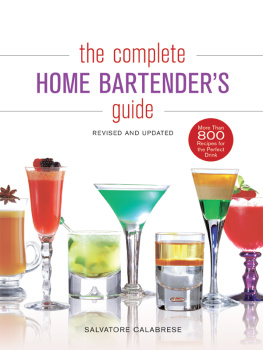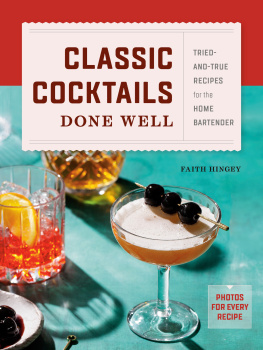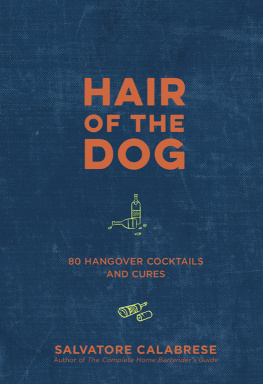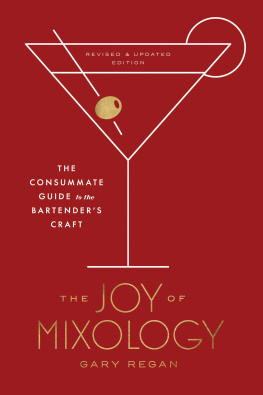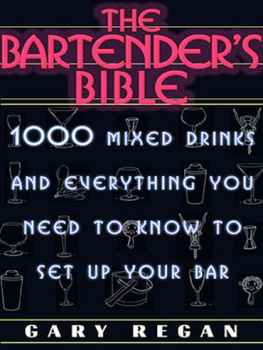The author would like to thank everyone who made this book possible. It was a mammoth task and a great team helped me put it together. Firstly, to my publishing duo, Lincoln Boehm and Charles Nurnberg, a great thank-you. To Lynn Bryan, thanks. Thanks also to Limelight Management. To the team of bartenders at The Library Bar: George, Fabrizio, Stevan, Matteo, Jack, Fiore, and Sophia: many thanks for being there. To all other bartenders (including Jerry Mignot, Dick Bradsell, and Dale deGroff) whose recipes I selected, thanks!
The BookMaker would like to thank Dartington, Riedel, and WaterfordWedgwood for their kindness in loaning glassware, as well as Christofle, Thomas Goode, and Harrods.
tools & equipment

glassware

bar essentials

bar terms

general advice

easy techniques

flavors & garnishes

party planning
tools & equipment
There are certain tools and equipment that help you make delicious cocktails. Most can be found in the bar section of department stores.
BAR KNIFE
A small, sharp knife used for slicing fruit.
BARSPOON
It has a small bowl at the end of a handle.
BLENDER
Use to combine spirits, juice, fruit, and ice.
BOTTLE OPENER
Choose the least-complicated opener that feels good in your hand and is strong.
CHAMPAGNE STOPPER
Useful for saving the bubbles in a bottle.
CHOPPING BOARD
Use to slice fruit for garnishes.
COCKTAIL STICKS
Use for spearing pieces of cherries and other fruit for garnishes.
CORKSCREW
Use to open wine bottles.
DECORATIVE COASTERS
Use if you have tabletops that mark easily.
DASH POURER
Use for drops and dashes of bitters and some liqueurs when floating them.
GRATER
Use to dust a drink with chocolate or nutmeg.
ICE BUCKET AND TONGS
Make sure the bucket is wide enough to hold lots of ice. Use the tongs!
ICE SCOOP
Use to add ice to a shaker or blender.
JUICER
Important for making fresh grapefruit, orange, lemon, and lime juices.
MIXING GLASS
Used for mixing two or more ingredients with a barspoon.
MUDDLER
Use to mash sprigs of mint or berries into a pulp in the bottom of a mixing glass or an old-fashioned glass.
PONY-JIGGER
Use for correct measures to balance the flavors and strength of a cocktail.
SALT AND PEPPER GRINDERS
Use to add a spicy flavor in cocktails, such as Bloody Mary.
SHAKER
Use for mixing various spirits and juice together with ice.
STIRRERS
Stirrers can be made from glass or silver, with patterns and characters.
STRAWBERRY HULLER
Use to remove the stem and hull from a strawberry.
STRAWS
Use short straws for small glasses; for highballs and goblets, use two longer straws. Plain straws are best.
ZESTER
Use on lemon, orange, and lime peels to make garnishes.

1 Clockwise from top: Dash pourer, cloth for cleaning glasses, Angostura bitters, corkscrew and bottle opener, stirrers, and small grater

2 Left to right: Shaker, mixing glass with stirrer, two-piece silver shaker based on the Boston shaker, strainer, and pony-jigger

3 Clockwise from top: Juicer, lime squeezer, zester, and muddler
glassware
Fine, clear glasses with thin lips are best for showing off cocktails. Traditionally, each type of drink has a glass shape specifically for it. For instance, a long drink needs a highball; a Martini is served in a cocktail glass, and a Pia Colada loves a colada glass. A liqueur needs a small glass, as does a straight shot of a spirit.
When buying glasses, look for those with a design on the stemit adds a visual interest to the presentation.
Always handle a stemmed glass by the stem, not the bowl, to keep the cocktail chilled. And keep a clean cloth nearby to polish glasses.
MAIN GLASS TYPES AND SIZES
| Cocktail | 4oz/12cl |
| Old-fashioned | 5oz to 6oz/15cl to18cl |
| Shot | 2oz to 3oz/6cl to 9cl |
| Liqueur | 2oz to 3oz/6cl to 9cl |
| Highball | 10oz/30cl |
| Wine | 4oz to 9oz/12cl to 27cl |
As you can see from the photograph, there are many glass styles. However, you need only a basic few. The cocktail glass is by far the most popular shape for almost any cocktail served without ice. A flute is essential for a champagne cocktail!


CHAMPAGNE FLUTE
A flute is sophisticated and is preferred over those shaped like a saucer. (This shape was modeled on Frances Empress Josephines breast. However, it makes the champagne go flat quicker.)
COCKTAIL
A regular cocktail glass is best for the recipes in this book. A double cocktail glass is occasionally called for.
GOBLET
This is the original large glass and is best for exotic cocktails with lots of color, a few juices, and a big garnish on the side.
HIGHBALL
Used for long drinks and ideally should be wide at the rim. (If its not, then you can catch your nose when you sip the drink!)
IRISH COFFEE
Designed to withstand the heat of coffee, it has a stem.
LIQUEUR
A small glass used for serving after-dinner digestifs.
OLD-FASHIONED
A short glass with a heavy base sits perfectly in the palm of your hand.
PORT
Designed for serving port or sherry.
PUNCH OR TODDY
Designed for holding hot drinks such as mulled wine; it usually has a handle.
SHOT
Designed for a measure of a strong spirit or spirits (pousse-caf-style) that are downed in one gulp.
WHITE AND RED WINE
Wine glasses are good for cocktails that include fruit juices and a fancy garnish. White glass sizes range from 4oz/12cl to 6oz/18cl; red glass sizes range from 6oz/18cl to 9oz/27cl.
bar essentials
SPIRITS
bourbon
brandy
gin
Pimms No. 1 Cup
vodka
white (silver) and gold tequila
whiskey
white and dark rum
sak
LIQUEURS
amaretto
Next page
